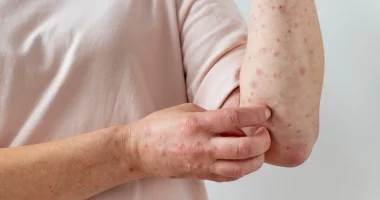Apnea, a condition characterized by temporary cessation of breathing, can be disruptive and potentially dangerous. It commonly manifests during sleep, leading to snoring, gasping, or choking episodes. OSA occurs when the airway collapses or becomes blocked, while central sleep apnea involves a failure of the brain to signal the muscles to breathe. Both types can result in fragmented sleep, daytime drowsiness, and diminished cognitive function.
Untreated apnea may increase the risk of cardiovascular problems, hypertension, and stroke. Management typically involves lifestyle changes, such as weight loss or positional therapy, along with medical interventions like continuous positive airway pressure (CPAP) therapy or oral appliances. Seeking prompt diagnosis and appropriate treatment is crucial for mitigating the potential complications associated with apnea.
Causes
Apnea can stem from various underlying factors, often categorized into obstructive and central causes. Sleep apnea happens when the muscles in the throat takes rest extremely during sleep, leading to airway blockage or collapse. Contributing factors may include obesity, large tonsils or adenoids, or structural abnormalities in the airway.
Central sleep apnea, on the other hand, arises from a malfunction in the brain’s respiratory control center, which fails to deliver correct signals to the muscles responsible for breathing. This type can be linked to conditions such as congestive heart failure, stroke, or certain neurological disorders. Additionally, lifestyle factors like smoking, alcohol consumption, or sedative use can exacerbate both types of apnea. Understanding the specific causes of apnea is crucial for implementing effective treatment strategies tailored to each individual’s needs.
Symptoms
The signs of apnea are presented in bullet points:
- Loud and persistent snoring
- Instances of interrupted breathing while asleep, frequently noticed by a sleeping companion
- Choking or Gasping feelings during sleep
- Fatigue or extreme daytime sleepiness
- Headache in the morning
- Memory problems and difficulty concentrating
- Mood swings
- Decreased libido or sexual dysfunction
- Frequent nocturnal awakenings
- Sore throat or Dry mouth upon waking
These symptoms may vary in severity and frequency among individuals and are often more pronounced in OSA but can also occur in CSA. If experiencing any of these symptoms, it’s important to seek medical evaluation for proper diagnosis and management.
Treatment
Treatment for apnea typically involves a togetherness of lifestyle modifications, medical interventions, and sometimes surgical options. Lifestyle changes may include weight loss, as excess weight can contribute to airway obstruction, positional therapy to encourage sleeping in a specific position that keeps the airway open and avoiding alcohol and sedatives, which can relax the throat muscles and worsen apnea.
Continuous positive airway pressure (CPAP) therapy is a common medical intervention, involving the use of a machine that delivers a steady stream of air through a mask worn over the nose or nose and mouth during sleep, helping to keep the airway open. For those who find CPAP challenging, other options include bilevel positive airway pressure therapy, oral appliances that reposition the jaw to keep the airway open, or adaptive servo-ventilation for CSA.
In some cases, surgical procedures may be considered to address anatomical abnormalities contributing to obstructive sleep apnea, such as tonsillectomy or adenoidectomy, uvulopalatopharyngoplasty (UPPP) to remove excess tissue in the throat, or maxillomandibular advancement surgery to reposition the upper and lower jaw. However, surgery is typically reserved for cases where other treatments have been ineffective or in situations where the anatomy of the airway significantly contributes to the apnea. Ultimately, the most appropriate treatment plan for apnea depends on the severity of the condition, individual patient factors, and preferences, and should be determined in consultation with a healthcare professional specializing in sleep disorders.
Risk factors
Several factors can increase the risk of developing apnea, including obesity, as excess weight can lead to fat deposits around the upper airway, potentially obstructing airflow during sleep. Anatomical abnormalities, such as large tonsils or adenoids, a narrow airway, or a recessed jaw, can also contribute to airway obstruction. Age plays a role, as apnea becomes more prevalent with increasing age, with middle-aged and older adults being at higher risk. Gender is another factor, as men are more likely than women to develop apnea, although the risk for women increases after menopause.
Lifestyle habits like smoking, alcohol consumption, and sedative use can relax the muscles of the throat, exacerbating apnea symptoms. Additionally, family history may predispose individuals to apnea, suggesting a genetic component. Certain medical conditions, such as congestive heart failure, hypertension, diabetes, or neurological disorders, can also increase the risk of apnea. Identifying and addressing these risk factors can be crucial in managing and preventing the development of apnea.
Management
Managing apnea involves a combination of lifestyle changes, medical interventions, and sometimes surgical options. Here are key points for managing apnea:
Lifestyle Modifications
Maintain a healthy weight through diet and exercise. Avoid alcohol, sedatives, and sleeping pills, especially before bedtime. Establish regular sleep patterns and maintain good sleep hygiene practices. Elevate the head of the bed to improve breathing and reduce snoring.
Continuous Positive Airway Pressure Therapy
Use this machine, which delivers a continuous flow of air across a mask worn over the nose or nose and mouth during sleep. CPAP therapy helps keep the airway open and prevents apnea episodes.
Oral Appliances
Consider using oral appliances prescribed by a dentist or sleep specialist. These devices reposition the jaw and tongue to put the airway open while sleeping.
Bi-level Positive Airway Pressure Therapy
BiPAP machines deliver varying levels of air pressure, adjusting to the individual’s breathing patterns. They may be used for individuals who find CPAP therapy uncomfortable or ineffective.
Adaptive Servo-Ventilation Therapy
ASV therapy is used for central sleep apnea and complex sleep apnea syndrome. It delivers positive airway pressure that adjusts to the patient’s breathing patterns.
Surgical Options
Surgeries may be considered to address anatomical abnormalities contributing to obstructive sleep apnea. These may include tonsillectomy, adenoidectomy, uvulopalatopharyngoplasty (UPPP), or maxillomandibular advancement surgery.
Positional Therapy
Encourage sleeping on the side rather than the back to reduce the likelihood of airway obstruction. Positional therapy devices may help maintain a side sleeping position.
Regular Monitoring and Follow-up
Regularly monitor symptoms and treatment effectiveness with a healthcare provider. Adjustments to treatment plans may be necessary based on individual responses and changes in symptoms over time.
Prevention
Preventing apnea often involves addressing underlying risk factors and adopting healthy lifestyle habits. Maintaining a healthy weight through a balanced diet and regular exercise can reduce the chance of obesity-related apnea. Avoiding alcohol, sedatives, and smoking, particularly before bedtime, can help prevent relaxation of the throat muscles and airway obstruction.
Establishing consistent sleep patterns and practicing good sleep hygiene, such as sleeping on the side instead of the back, can also reduce the likelihood of apnea episodes. Additionally, regular check-ups with healthcare providers to monitor overall health and address any underlying medical conditions can contribute to prevention efforts. Early intervention and management of risk factors are key in reducing the likelihood of developing apnea.
Summary
Apnea, characterized by temporary breathing cessation during sleep, presents risks of fragmented sleep, daytime drowsiness, and cardiovascular complications if left untreated. Its causes range from anatomical factors to lifestyle habits and medical conditions. Treatment options include lifestyle changes, CPAP or BiPAP therapy, oral appliances, and surgical interventions.
Management involves weight loss, avoiding alcohol and sedatives, and maintaining consistent sleep patterns. Prevention strategies focus on maintaining a healthy weight, avoiding substances that relax the throat muscles, and practicing good sleep hygiene. Regular monitoring and early intervention are crucial for effective management and prevention of apnea.









